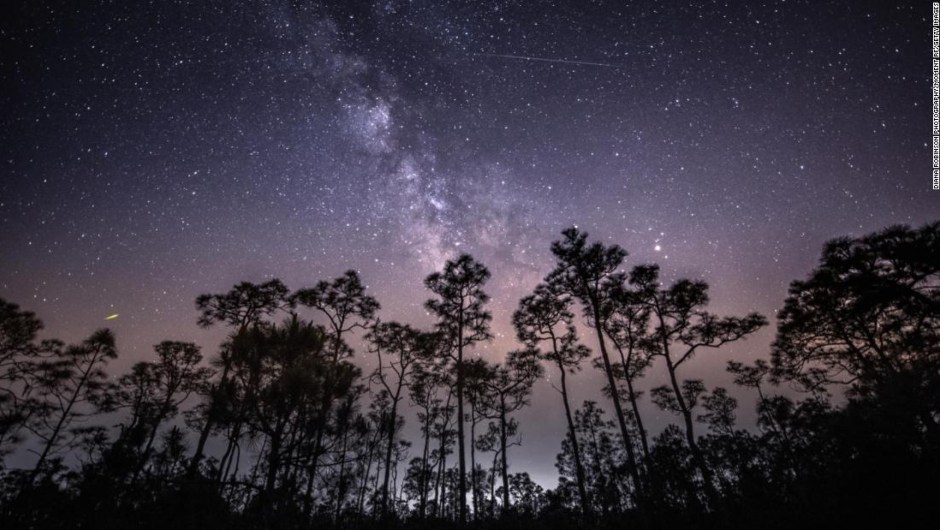(CNN) -
In the early hours of Wednesday morning, the Eta Aquariids meteor shower will shoot streams of light across the sky.
The rain lasts from April 19 to May 28, but the best time to see it is when it peaks before sunrise on May 5, according to EarthSky.
There may also be a meteor spray on the morning of May 6.
A bright moon can negatively affect the visibility of meteors, but luckily, a waning crescent moon will appear in the sky on May 5 and 6.
Moonlight shouldn't drastically affect stargazers' ability to see rain, EarthSky said.
The Eta Aquarids will be visible in the northern and southern hemispheres, but vision will be better in the southern hemisphere, according to NASA.
Cloud cover can be a problem for some people in the United States who are waiting to see the meteor shower.
Around dawn on May 5, most of the US east of the Mississippi River will see significant cloud cover, said CNN meteorologist Taylor Ward.
Aside from some clouds over the central Rocky Mountains and the Northern Plains, the rest of the country should have fairly clear skies, Ward added.
advertising
During peak activity, stargazers can expect to see meteors traveling at an average of 70 km per hour, NASA said.
Spectators should see a number of light trails, but few fireballs, according to the American Meteor Society.
Fireballs are brighter than the average meteor and tend to last longer.
Meteors originate from Halley's Comet, the famous comet that only appears once every 76 years, according to NASA.
It was last seen in our skies in 1986, and it won't appear again until 2061.
More meteor showers to see
The Delta Aquarids are best viewed from the southern tropics and will peak between July 28-29 when the moon is 74% full.
Interestingly, another meteor shower peaks on the same night: the Alpha Capricorns.
Although this is a much weaker shower, it is known to produce some bright fireballs during its peak.
It will be visible to everyone, regardless of which side of the equator they are on.
The Perseid meteor shower, the most popular of the year, will peak between August 11-12 in the Northern Hemisphere, when the moon is only 13% full.
Here's the meteor shower schedule for the rest of the year, according to EarthSky's meteor shower forecast.
October 8: Draconids
October 21: Orionids
November 4-5: Southern Taurids
November 11-12: Northern Taurids
November 17: Leonidas
December 13-14: Geminids
December 22: Ursidas
Full moons in 2021
Typical of a normal year, there are 12 full moons in 2021. (There were 13 full moons last year, two of which were in October.)
Here are the rest of this year's full moons and their names, according to The Old Farmer's Almanac:
May 26 - Flower Moon
June 24 - Strawberry Moon
July 23 - Deer Moon
August 22 - Sturgeon Moon
September 20 - Harvest Moon
October 20 - Hunter's Moon
November 19 - Beaver Moon
December 18 - Cold Moon
This is what you can also expect in 2021.
Solar and lunar eclipses
This year, there will be two eclipses of the sun and two eclipses of the moon, and three of these will be visible to some in North America, according to The Old Farmer's Almanac.
A total lunar eclipse will occur on May 26, most visible to those in western North America and Hawaii from 4:46 am ET to 9:51 am ET.
An annular solar eclipse will occur on June 10, visible in northern and northeastern North America from 4:12 am ET to 9:11 am ET.
The sun will not be completely blocked by the moon, so be sure to wear eclipse glasses to view this event safely.
You'll see a partial lunar eclipse on November 19, and sky watchers in North America and Hawaii can see it between 1 a.m. ET and 7:06 a.m. ET.
And the year will end with a total solar eclipse on December 4.
It won't be visible in North America, but those in the Falkland Islands, the southern tip of Africa, Antarctica and southeastern Australia will be able to detect it.
Full moon in April 2021: this is what the 'pink' supermoon looked like
Visible planets
Sky watchers will have multiple opportunities to spot planets in our sky on certain mornings and nights throughout 2021, according to the Old Farmer's Almanac planetary guide.
Most of these can be seen with the naked eye, with the exception of distant Neptune, but binoculars or a telescope will provide the best view.
Mercury will appear as a bright star in the morning sky from June 27 to July 16 and from October 18 to November 1.
It shines in the night sky until May 24, August 31 to September 21, and November 29 to December 31.
Venus, our closest neighbor in the solar system, will appear in the western sky at dusk in the afternoons of May 24 to December 31.
It is the second brightest object in our sky, after the moon.
Mars makes its reddish appearance in the morning sky between November 24 and December 31, and will be visible in the evening sky until August 22.
Jupiter, the largest planet in our solar system, is the third brightest object in our sky.
It will be on display in the morning sky until August 19.
Look for it in the evenings from August 20 to December 31, but it will be at its brightest from August 8 to September 2.
Saturn's rings are only visible through a telescope, but the planet itself can still be seen with the naked eye in the mornings until August 1 and in the afternoons from August 2 to December 31.
It will be brightest during the first four days of August.
NASA discovers radio signal on Venus and this is how it sounds in its atmosphere
Binoculars or a telescope will help you spot the greenish glow of Uranus in the mornings from May 16 to November 3 and in the afternoons from November 4 to December 31.
It will be brightest between August 28 and December 31.
The solar system's distant neighbor, Neptune, will be visible through a telescope in the mornings until September 13 and during the afternoons from September 14 to December 31.
It will be brightest between July 19 and November 8.
Meteorite




